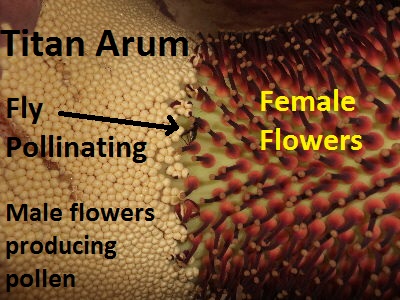Tip of the Week – Focus on Pollination
 For many of us the first thing we learn about pollen is that it makes us sneeze in spring if we have an allergy to it. But this is the airborne dust sized pollen and there are many many other types.
For many of us the first thing we learn about pollen is that it makes us sneeze in spring if we have an allergy to it. But this is the airborne dust sized pollen and there are many many other types.
What is Pollen?
Pollen is the male gamete sent out by a plants male flowers seeking to combine with a female flowers ovule. Pollen contains the male chromosomes for the mating process. When the two combine this is a plants sexual reproduction process and from this process seeds are produced which given the right conditions will germinate and produce more plants.
How Many Types?
Every plant has its own unique pollen not only in chromosome makeup but in shape and size and method of dispersal! There are dust like pollens produced in squillions and dispersed by the wind in the hope of finding a female mate. Good luck! There are the bigger sticky waxy balls of pollen used by orchids which stick to the bodies of insects, mammals and even hummingbirds to transfer the pollen in pollination. For Amorphophallus and other Aroids the male and female flowers are next to each other & beetles and flies transfer the pollen to the female. The gingers and heliconias of South America are pollinated by humming birds. Hoyas are pollinated by ants while the honey bee works one specific crop at a time like River Red Gum or Yellow Box trees and many fruits & vegetables.
The Pollination Process
The pollinator will land the grain of pollen on the Stigma of the female flower where proteins detect whether genetically compatible and if it is… the pollen grain will send a root down the Style of the female way down into the Ovary and Ovule where the male and female chromosomes meet for fertilisation and seed production.
Pollinators
Pollinators are simply insects and animals or birds that transfer pollen from the male flower to the female. There is usually a trade off in supplying the pollinator with food. In nature with Amorphopallus it is usually the carrion beetle or dung fly which are attracted to a smell emitted by all the carrion flowers and the brilliant colour of its spathe. Other specific pollinators are attracted by the specific smell a flower makes to attract just that one pollinator that has adapted to it. Some pollinators are attracted by the amazing colours of the floral arrangement. You will find in nature that every plant species will have a natural pollinator or two r in its native habitat. These relationships have been built up over millions of years.
Non Native Pollination
When a plant is taken out of its natural environment to another area it may become more difficult to produce seed. Often new pollinators will be attracted but they may be clumsy and not do the job at all or as well as the specialised one at home. It is a fact that us humans can often assist in the pollination process with a knowledge of how its done in nature.
Natural Hybrids
Sometimes the Pollinator doesn’t get it quite right and delivers pollen to the wrong plant! Within a Genus some species types are compatible for sexual reproduction with another species of the same type…resulting in a Natural Hybrid.
